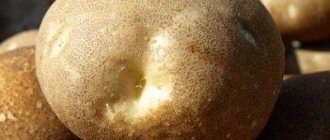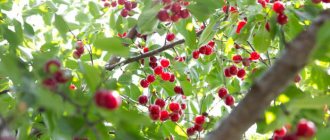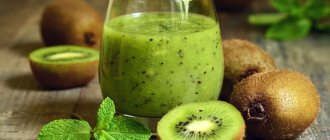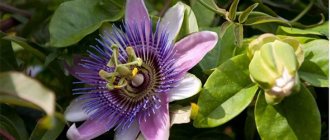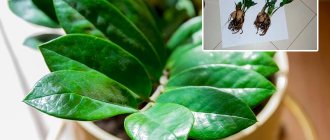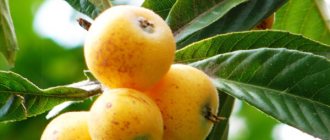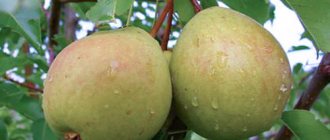Now in any supermarket you can buy kiwi fruits grown on large tree-like vines. They are also sometimes called Chinese gooseberries, but the correct name of the plant is Chinese gooseberry (Actinidia сhinensis var. deliciosa). Upon careful study of the crop, it turned out that in open ground in a place protected from the wind it can tolerate down to –20°C, and under cover up to –30°C. Therefore, if you “play” with winter shelters, you can try to grow it in the Moscow region in open ground, and not at home.
- How to distinguish male and female kiwi plants
- Kiwi: planting and care in open ground
- Forming and pruning kiwi
- Wintering kiwi in open ground
- Kiwi harvest
- Popular varieties of female plants
- Popular varieties of male plants
young kiwi fruits
How to distinguish male and female kiwi plants
I planted the first kiwi seedlings in my garden near Moscow about 10 years ago, but they didn’t bloom until 2012, although in the southern regions they bloom in the 3rd–5th year. The male plant bloomed first, and the next year the female plant bloomed at the same time as the male plant. Before flowering, it is difficult to determine the gender of kiwi, but when they bloom, this difference is clearly visible: on female flowers the pistil is much larger.
In the photo: Male kiwi flower
the varietal identity of the female plants (variety Hayward ) only when the plants bloomed and the fruits began to ripen. Not knowing how the local bees and bumblebees would receive the overseas guest, I played it safe a little: I hand-pollinated all the flowers on the female vines with a male flower.
In the photo: Female kiwi flower
The result was not long in coming, and now furry aliens from distant subtropics are ripening in my garden. However, I think that the insects could have managed it without my help. For the viability of pollen and the activity of pollinating insects, it is optimal that during the flowering period, which in our area occurs at the end of May - beginning of June, the air temperature is +15...+20 °C.
Fruiting
Kiwi will begin to bear its first fruits no earlier than 3 years after planting. Moreover, any violation of plant care will cause a “delay” in the appearance of fruits, so often the first fruits appear only after 10 years.
To obtain fruits, the presence of female and male vines is necessary. The sex of the plant can be determined by the flowers, but they will take at least 3 years to appear. Thus, it is more profitable to plant cuttings (because the sex will already be known), but when growing from seeds, you need to take only in quantity and hope that among the shoots there will be plants of both sexes.
Regardless of the variety, kiwis begin to ripen closer to the beginning of December. However, many people pick the fruits earlier (to have time to cover the vines before the first frost), and then leave them to ripen at home.
Kiwi: planting and care in open ground
Kiwi is planted in places protected from the north and northeast wind. It is best on the south side of the house. Spring planting is preferred. Usually 5-6 female plants are planted per male. Taking into account the fact that kiwi has a shallow root system, the planting hole is made shallow: 0.5 x 0.5 x 0.5 m. Kiwis love well-drained, humus-rich soils. The best ratio is 1–2 parts of rotted manure or compost to 1 part of garden soil. It is advisable that the root collar be 3 cm above the ground level, since deep planting can lead to the death of the plant.
In the photo: Planting a kiwi seedling in open ground
Kiwis love abundant watering, but without stagnant water. If the summer is dry, then once a week 20–30 liters per adult plant is enough. In rainy summers you can water much less often. In the year of planting, you can not feed, and in subsequent years - starting from May, approximately once a month, apply 20-25 g of nitrogen, 10 g of phosphorus, 10-20 g of potassium fertilizers per plant, finishing all feeding no later than July. Fertilizers containing chlorine should not be applied. Plants are sensitive to high lime content.
Taking into account the fact that this is a powerful, fast-growing vine, for good development it is immediately necessary to install racks (pillars) between which to stretch a support: wire or ropes. Kiwi is propagated by rooting cuttings, grafting and seeds. However, when propagated from seed, the vast majority of seedlings (70–90%) will be male plants, so it is better to purchase seedlings from collectors.
Diseases and pests are practically not found on kiwi under our conditions.
Soil preparation and sowing
The ideal place for planting is a hill where excess moisture will definitely not accumulate in the root system. At home, you can simply use special soil. Kiwi does not like clay soil or stagnant moisture. Also, the soil must be sufficiently nutritious and oxygenated.
When sowing, you should try to maintain a ratio of at least 1 male plant to 10 female plants.
Forming and pruning kiwi
I consider single-tier and two-tier palmettes to be the most successful form of growing kiwi.
In the photo: Grown kiwi in the Moscow region, Vladimir Bushnev’s garden
With a single-tier palmette, at a height of approximately 0.5–1 m, two sleeves are formed along a wire (rope) stretched between the posts. And with a two-tier one, there are two more sleeves at a height of 1.5–2 m. After planting a seedling from the young shoots, the strongest one is left and tied to a peg, and the remaining shoots are cut out. If the plant is planted in early spring, wait until the leaves bloom before pruning. When the shoot reaches the height of the first tier, it is cut off, thus stimulating the growth of side shoots, from which two sleeves are formed. In the spring, only dry branches are removed - at this time there is active sap flow, and if you cut off living tissue, the cut will “cry” for a long time. In summer or autumn, weak, fruit-bearing, thickening shoots are removed, leaving mainly those growing horizontally at a distance of 30–40 cm from each other.
Reproduction methods
There are several methods for growing exotic vines on your property. The easiest way to do this is when you already have one plant. In spring, the strongest shoot located below is pressed to the ground and covered with soil, leaving the end on the surface.
Cuttings
In the last days of July they resort to another method of reproduction. At this time, the fruits increase in size and the branches gain strength. Having chosen the strongest ones, they are shortened to a meter and the ends are placed in water. The shoots must have at least three buds for propagation by green cuttings to be successful.
First, the blanks are placed in a greenhouse, and only then grown in an open area. Gardeners who know how to plant actinidia will be enjoying the sweet and sour fruits within a few years.
Seeds
Is it possible to grow a tropical liana in any other way? Summer residents who do not have a plant to cut the shoot are interested in. From ripe fruits, you need to collect the seeds, peel the pulp and dry them.
Wintering kiwi in open ground
My kiwis are planted at a distance of 1 m from the southern wall of the house. In the first years, in November, I untied the ropes to which the vines were attached from the posts, and lowered the lashes as low as possible to the ground, trying not to touch it. The tree trunk circle was mulched to a height of about 10 cm. I placed two wooden shields in the form of a hut (0.5 m high) over the vines so that the snow falling from the roof would not break the vine, and covered the shields on top with 2-3 layers of polyethylene. The hut was partially covered with snow falling from the roof. At the beginning of spring, when night frosts stop falling below -15°C, the shelter was opened slightly so that on sunny days there would be no greenhouse effect and the vine would not wake up ahead of time. For a vegetative vine, even a small minus is critical. Several years ago, when there was a frost of -5°C (May 8), the vines that had begun to grow were frozen to the ground. Fortunately, they did not die and by August they had fully recovered. Mature plants are difficult to bend to the ground. I had to slightly change the design of the winter shelter. In the fall, I lay cellular polycarbonate on the posts to which the vines are attached, attach one end of it to the wall of the house and make a small canopy. I untie the vines from the posts and tilt them towards the wall of the house. From the outside I cover them with 2-3 layers of polyethylene, which I attach to the racks. In such a winter shelter without additional heating, the vines overwinter almost without damage. Only immature shoots are frostbitten. In May, when the threat of frost has passed, I remove the polyethylene and polycarbonate.
In the photo: Winter box for wintering kiwi in open ground
Actinidia: varieties and varieties
About 75 species of woody vines are known in the world, and only 4 of them grow in Russia.
Actinidia kolomikta
- Actinidia kolomikta - deciduous liana. Wraps around the vertical support counterclockwise. Its shoots can reach 14 m. It has white and large flowers. They exude an unusual aroma, which attracts insects. It is an excellent honey plant. By autumn the bush becomes even more elegant. Flowers of different colors appear on it: pink, purple, crimson, etc. The plant will begin to bear fruit only after 5 years from the date of planting, although it can bloom after a 2-year interval. The fruits of Actinidia kolomikta are oblong, yellow with a large number of small seeds. When ripe they fall off. Two actinidia berries contain the daily requirement of vitamin C for an adult. The most popular varieties are “Grape”, “Waffle”, “Lakomka”, “Moma”, “Narodnaya”, etc.
Actinidia acute
- Actinidia acute (arguta) - one of the types of shrubs. It is distinguished from kolomikta by larger fruits that look like apples. The taste is apple-banana. People call this species raisins. Varieties - “Pineapple” and “Clara Zetkin”. Sometimes used as an ornamental plant.
Actinidia polygamous
- Actinidia polygamous. The liana is no more than 5 m high. Flowering begins in July, and the first fruits ripen at the end of August. The fruits of this species resemble vegetables more than fruits. The unripe fruit tastes like hot pepper, and when ripe it tastes like bell pepper. This species is not very frost-resistant, so it is recommended to cover it for the winter. “Apricot”, “Ogonyok” and “Pepper” are the most common varieties.
Actinidia chinensis (delicacy)
- Actinidia chinensis (delicacy) is the most famous species. It is popular due to its tasty and healthy fruits - kiwi. It is grown for food and is also a wonderful decoration for the landscape.
Popular varieties of female kiwi plants
- Hayward is the most widespread kiwi variety in the world. Late ripening. Vigorous. Productivity is high. The flowers are initially white, and after 2–3 days they become creamy, up to 6.5 cm in diameter, solitary, rarely in inflorescences of 2–3 flowers. Flowering lasts 10–14 days. The fruits are large, smooth, oval in cross section. Fruit length up to 6.5 cm, weight up to 100 g. The pulp is straw-greenish.
- Bruno – early ripening. Vigorous. The flowers are white-cream, 5.5 cm in diameter, either solitary or collected in inflorescences of 2–3 pieces. Flowering lasts 10–12 days. The fruits are cylindrical in longitudinal section and round in cross section. Length up to 8 cm, circumference – 12 cm, weight 50–70 g. The flesh is green.
- Monty – mid-season. Vigorous. The flowers are white-cream, up to 5 cm in diameter, solitary or in inflorescences of 2–3 pieces. Flowering lasts up to 12–14 days. The fruits are medium to large, slightly pear-shaped in longitudinal section and oval in cross section. Their length is 6.4 cm, circumference 13.8 cm, weight about 30 g. The flesh is greenish-yellow. The taste, unlike the listed varieties, is mediocre.
- Abbot is a mid-season kiwi variety. Medium height. The flowers are white-cream, up to 6.5 cm in diameter, both single and collected in inflorescences of 2–3 pieces. Flowering lasts 10–12 days. The fruits are evenly colored, elongated in the longitudinal direction and rounded in the transverse direction. Fruit length 6.6 cm, weight 65 g. The flesh is green.
- Jenny – medium early. Medium height. Self-pollinating. Fruits weigh up to 60–80 g. Similar to Hayward , but have smaller fruits.
How to order flowers for delivery?
Growing kiwi. Kiwi varieties. Kiwi planting and care Is it possible to grow exotic kiwi in areas where there is no subtropical climate, for example, in central Russia? The answer is yes. There are kiwi varieties that are adapted even for areas with harsh winters.
Growing kiwi will certainly require some effort, but if you provide proper care , then planting kiwi will not be in vain. Because it will delight you with delicious fruits, and will also add a little exotic to your site!
Kiwi is a delicious and wonderful exotic berry. However, kiwi is no longer particularly exotic for us and can be found on the shelves of any vegetable store. This is not surprising; thanks to its excellent taste, it is deeply loved by ordinary people.
However, some people do not want to be content with imported kiwis and want to grow their own kiwi bush , being prepared for any difficulties. If you are the same person, then it is not in vain that you decided to read this article, because today in it we will look at where kiwi came from, the varieties of kiwi, as well as planting and caring for it.
Origin of kiwi
There is a misconception that kiwi can be found in the wild. But this is not true at all. The berry is relatively young, it is only 82 years old and was bred through selective breeding. And it got its name in honor of the kiwi bird, which is so similar in color and fluffiness to these berries.
This miracle was brought out by Alexander Ellison, who, wanting to grow flowers of the Chinese decorative vine mihutao, decided to increase the amount of color and its beauty.
It was almost impossible to eat Mihutao or possible, but only for lovers of something tough and absolutely tasteless.
By cultivating this wild vine, Alexander and several of his colleagues achieved an unexpected result. After 30 years of their hard work, they received not only a beautiful color, but also delicious fluffy berries of quite large size. Kiwi brought simply enormous yield, the vine grew non-stop every day, so gardeners had to sweat over its constant pruning, but the pleasant bonus in the form of fruits that could be collected every other day was worth the effort.
But fellow gardeners were in no hurry to share their wealth. They preferred to keep the berries a secret and enjoy the most unusual taste themselves. Until James McLoughlin, being bankrupt and practically poor, bought several bushes from Alexander, who took pity on the man’s condition.
Kiwis simply broke through the local markets. This was an absolute novelty for the whole world. James, being a smart man, immediately began to expand the number of bushes on his plot until he planted an entire plantation, becoming a rich man.
Miracle bushes immediately scattered throughout New Zealand, and became extremely popular among local residents, and soon throughout the world.
Kiwi varieties
Kiwi variety "Hayward"
One of the largest varieties of kiwi that will not disappoint you. It requires quite a lot of space, like any other vine. Grows in subtropical conditions. Under proper conditions, it begins to bloom in the third week of May and flowering continues until the very end or until the end of the first week of June. Requires a pollinator variety nearby.
Kiwi variety Hayward
It has medium-sized leaves that are slightly concave inward and have a dark green color, while the top seems to be slightly covered with wax, and the bottom is rougher.
The fruits are large, up to 150 grams, oval and slightly flattened on the sides. The peel is fluffy, brown with greenish splashes. In subtropical conditions it ripens by the end of October.
In the first year of fruiting it can produce up to 26 kilograms, in the second up to 67 kilograms, in the third up to 93 kilograms, and so on in increasing order. Therefore, this variety is extremely popular in all countries and is grown both for sale and for oneself everywhere. At the same time, if the basement is cool, the berries can be stored for up to six months.
The fruits are very juicy and tasty, therefore they are used for sale, fresh consumption and for preparing various dishes with the addition of kiwi or as an additive for marinade.
By the way! Kiwi is the best ingredient for marinating meat, because it softens it and makes it softer. But kiwi should not be added a day before cooking, otherwise it will simply eat away all the meat and turn it into a shapeless piece; add kiwi 2-3 hours before cooking.
Kiwi variety "Bruno"
This variety is in second place, because it differs from its predecessor in lower yield.
Kiwi variety Bruno
This variety also grows in subtropical climates, but has a more moderate growth. The leaves are oblong, pointed towards the end and slightly concave towards the middle. They have a dark green color. Not capable of self-pollination.
It blooms by the third week of May and stops blooming after 9-13 days. The fruits are slightly smaller, up to 70 grams per fruit, and have an elongated oval shape. The color of the peel is brownish, the peel is also covered with short hairs, which gives the berry a fluffy appearance. The yield in the third year is up to 60 kilograms per bush. Kiwi can be stored in the basement for up to 4 months. At the same time, it has a high level of transportability, does not wrinkle and does not lose its presentation on the road.
Kiwi variety "Monty"
Kiwi variety Monti
Unlike its predecessors, this variety is much smaller and therefore rarely used for sales. Basically, it is grown either for oneself or for some technical purposes. Its leaves are large, somewhat similar to the leaves of the Bruno variety.
The variety is vigorous and requires constant pruning, otherwise it will be extremely difficult to control its size. Cannot self-pollinate, requires a pollinator variety.
As mentioned earlier, Monti’s fruits are much smaller than in previous varieties. The weight of one fruit rarely exceeds 30 grams. But the color appears already in the second week of May and lasts only two weeks.
Kiwi variety "Abbot"
Abbot kiwi variety
This variety is slightly better than Monty, but requires some special care.
There should not be too many fruits on it, otherwise they will grow smaller and sour, so the load will have to be adjusted independently.
At the same time, this kiwi loves moisture, both in the air and in the soil. You also cannot forget about pruning, because the variety is fast-growing and will have to be pruned often. Not capable of self-pollination.
The fruits are medium-sized, weighing up to 70 grams per fruit. It has a shape similar to a pear. Doesn't last long, only 2-3 months in a basement. But the taste still compensates for all the inconveniences.
Kiwi variety "Allison"
This variety requires a pollinator variety nearby. At the same time, this is a fairly productive fruit, but it is also fast-growing, and therefore requires frequent pruning to control its size.
The fruit is bell-shaped and dark brown in color, covered with small short hairs, which gives it a fluffy appearance. The yield for the 9th year is up to 72 kilograms, despite the fact that one fruit weighs on average up to 45 grams.
Kiwi variety "Matua" (male)
The Matua kiwi variety
does not produce fruits, but it does provide them. After all, it belongs to the male pollinating varieties.
It has small inflorescences, up to 7 flowers in one. It blooms for about two weeks, which is extremely beneficial, because it has time to fertilize varieties that bloom earlier or later.
After flowering, it leaves behind a peduncle, so it will be difficult to confuse it with other varieties when you prune kiwi.
Kiwi variety "Tomuri" (male)
Kiwi variety Tomuri
is also a pollinator variety. More tall and blooming profusely.
With proper placement, one such bush can fertilize up to 6 kiwi bushes, which is an extremely profitable option. Therefore, it is often used for growing kiwi on plantations. But it is often used in home gardening, if there is space, but if desired, it can simply be trimmed with high quality.
It is used more often than its brother Matua precisely because of its profitability. The main thing is to place this variety advantageously among the others or to prune it so that it grows along a certain necessary trajectory.
Planting kiwi
Miracle botanists have long created kiwi varieties that are resistant to our severe frosts. You just need to purchase the necessary tree. And when you have finally done this, you can start planting! Planting occurs in summer and spring, and for small bushes up to three years old it can be done in the fall, but only if you are completely sure that there will be no frost at night.
The main thing, of course, is to choose a place for the kiwi. The bush likes clay soils and that groundwater does not pass too close to the roots. You should also take care of the support in advance. After all, kiwi is a vine-bush and it will need to entangle itself with something. This something can be anything from a picket fence to a fence, the most important thing is that this support can withstand the weight of the fruit, which can reach 100 kilograms.
The depth of the hole in which you will plant the kiwi should be up to 40 centimeters and the width up to 30 centimeters. A drainage layer is laid at the bottom of the hole, which can be chosen at your discretion, from ordinary stones to crushed stone, the main thing is to ensure that there is no standing water. After that, a seedling is placed in the hole, which is covered with earth, but under no circumstances compacted. After this, the plant is thoroughly watered and mulched with sawdust. For a while, until the kiwi gets stronger, it is worth providing it with diffused light, so as not to put the bush into even greater stress. The distance between several kiwis should be at least 2 meters.
Kiwi care
Since the plant is subtropical, it should receive proper care! It is worth providing the kiwi with proper watering so that the soil does not dry out too much, but it is also important to avoid standing water. In the second year after planting, the bush is fed with universal fertilizer. It is very important that it does not contain chlorine.
Some varieties will not have time to ripen before frost, so they ripen while lying in the house, in the warmth.
The main thing is to have time to collect the fruits before frost and have time to provide the kiwi with proper protection from frost. Young plants are covered with spruce branches or covering material, or covered with fallen leaves, straw, or, in extreme cases, sawdust. The lashes of an adult vine are removed from the support and laid on the ground; they can also be covered with spruce branches or wrapped with covering material. It is undesirable to use polyethylene film, as it will create a greenhouse effect and without air access, heating is possible.
Also try to fence off the bush from animals, especially from felines, who also don’t mind eating kiwi, or rather its leaves. Because of these robbers, some gardeners found only a dug hole in the place of the planted kiwi.
And so, today we met such a wonderful plant as kiwi! Growing an exotic fruit in our modern world is not so difficult, and botanists have long developed frost-resistant varieties that will survive at -30°C. The main thing is desire.
Grow kiwi for yourself!
Excellent(2)Bad(0)
Popular varieties of male kiwi plants
- Matua is a profusely and long-flowering variety. Vigorous. Flowers – from single to collected in inflorescences of 3–5 pieces. The villi on the peduncle are single and short.
- Tomuri - blooms somewhat later than the Matua . Vigorous. Flowering is long lasting, but less abundant. The flowers are large, from single to collected in inflorescences of 2–7 pieces. The villi on the peduncle are thin and long.
In the photo: Kiwi fruit grown in open ground in the Moscow region
Find out how to grow figs in open ground in the middle zone.
Growing kiwi from seeds
To grow a vine from seeds, you will need:
- ripe fruit;
- river sand, well washed;
- fine expanded clay, which will provide drainage;
- mini-greenhouse (can be replaced with plastic film;
- prepared slightly acidic or neutral soil for citrus fruits or roses (can be purchased at specialty stores).
A mixture of chernozem, peat and sand can be used as soil for germinating seeds. When you transplant seedlings into pots, this mixture is also great, but you need to use less peat.
Kiwi shoots grown from seeds
Follow the step-by-step instructions to get high-quality results.
- Mash the kiwi fruit to a puree and remove the seeds. Rinse them thoroughly and mix with moistened river sand.
- In order for the seeds to germinate well, they need to be stratified. Keep the bowl with the mixture of sand and seeds for 2 weeks at a temperature of 10 to 20 degrees, then place it in the refrigerator for 2-3 weeks.
- Place fine expanded clay at the bottom of the growing pots and pour soil on top. Mix the top layer of soil with a mixture of sand and seeds. Moisten with water at room temperature.
- Place the pots with seeds in a mini-greenhouse (can be covered with film or glass). Install them in a well-lit, warm place. Don't forget to spray and ventilate daily.
- As soon as the first shoots appear, begin to accustom them to fresh air. Every day, remove the lid from the greenhouse for a few minutes, gradually increasing the time.
- When the second pair of true leaves appears, make a pick and plant the plants in separate pots. At the same time, be careful: the root system of kiwi is very delicate, located on the surface, and can be easily damaged.
Formation
Actinidia can and should be formed. Here are some options for vine palmettes. Formation will take several years.
Top dressing
Fertilizers are applied to the soil according to a certain pattern.
in autumn:
- humus – 2-3 kg/sq.m;
- superphosphate – 40-50 g/sq.m;
- potassium salt – 10-15 g/sq.m.
In spring : ammonium nitrate – 20-30 g/sq.m.
In hot weather, plants need to be watered regularly. The top layer is periodically loosened, mixed with sawdust and peat.

